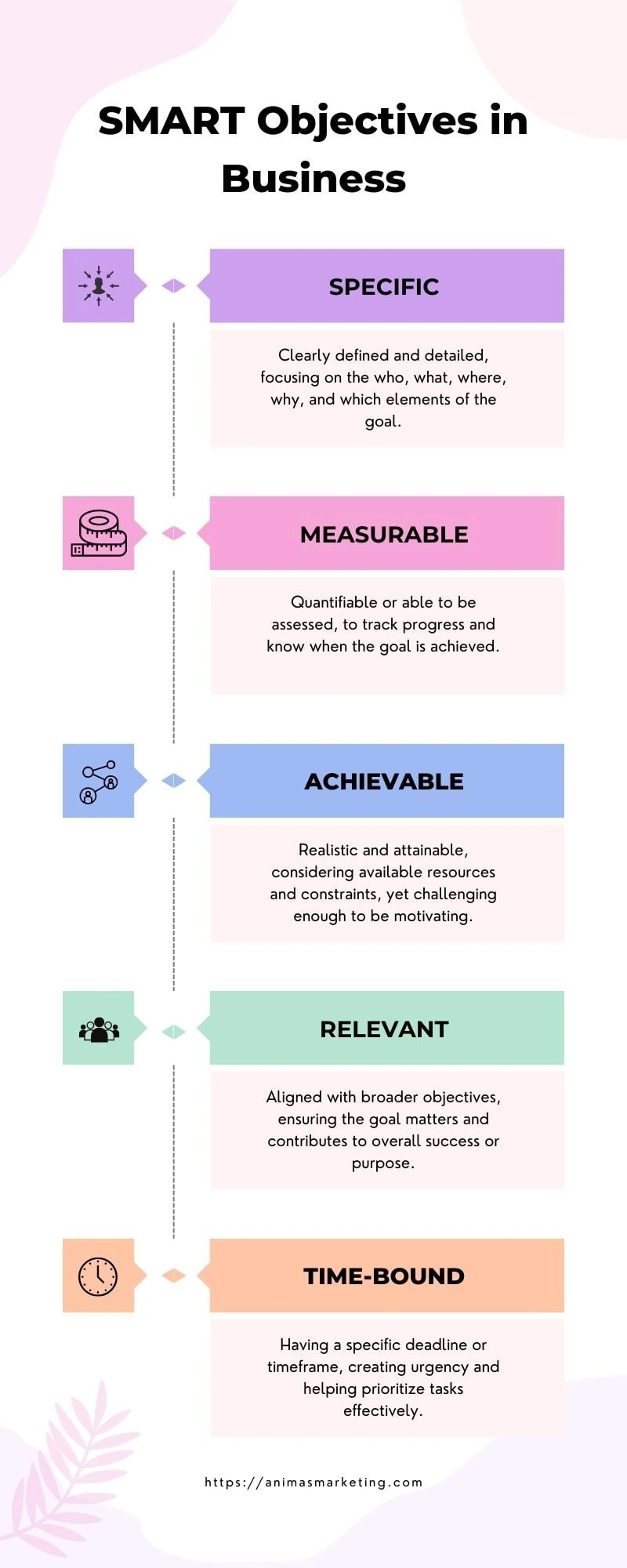If you are involved in the world of business, then you know that setting clear and achievable objectives is crucial.
This is where the concept of SMART objectives comes into play.
An acronym for Specific, Measurable, Achievable, Relevant, and Time-Bound, SMART objectives provide a framework that helps businesses set and achieve effective goals. Originally developed as a management tool, this methodology has become a cornerstone in strategic planning across various industries.
Understanding what SMART objectives are, and how they can be applied, is essential for businesses looking to streamline their goal-setting process and achieve measurable success.
SMART Objectives Infographic

Breaking Down SMART: What Each Letter Stands For
What are the SMART criteria? While SMART goals can be interpreted in various ways, there are some basic foundational concepts to each step of the acronym.
Specific: The Importance of Clear and Precise Goals
Specific objectives are well-defined, clear, and unambiguous. They precisely outline what needs to be accomplished, who is responsible, where it will happen, and which resources or limits are involved. For a goal to be specific, it should answer the five ‘W’ questions: Who, What, Where, When, and Why.
Measurable: Defining Criteria for Tracking Progress
A measurable objective allows for tracking progress and measuring the outcome. This involves quantifying goals using data, metrics, and milestones. For instance, instead of saying “increase sales,” a measurable objective would be “increase sales by 15% in the next quarter.”
Achievable: Setting Realistic and Attainable Objectives
Achievable objectives are realistic and attainable within the resources, knowledge, and time available. This aspect of SMART encourages setting ambitious yet realistic goals, pushing teams to stretch their abilities but not to the point of frustration or futility.
Relevant: Ensuring Goals Align with Business Vision and Values
Relevance refers to setting goals that align with broader business objectives and the strategic direction of the organization. A relevant objective should matter to the business and address a core aspect of its growth or improvement.
Time-Bound: The Significance of Setting Timelines
Time-bound objectives have a clear deadline – making it easier to track progress. This element instills a sense of urgency and prompts action. Time-bound goals answer the question of “by when” the objective should be achieved.
The Importance of SMART Objectives in Business Planning
Incorporating SMART objectives into business planning brings numerous benefits. They provide a clear direction, ensuring that all team members understand what is expected and by when. This clarity enhances focus and prioritizes resources and efforts towards achieving these goals and allows you to set a proper action plan.
SMART objectives also facilitate better communication and alignment among teams. When each member is aware of the specific, measurable, and time-bound goals, it fosters a sense of shared purpose and collaboration.
This alignment is crucial for ensuring that different departments and teams work cohesively towards common business objectives.
Furthermore, SMART objectives drive motivation and accountability in the workplace. By setting achievable and relevant goals, employees feel more empowered and committed to the tasks at hand.
The measurable aspect allows for regular tracking of progress, providing opportunities for feedback and adjustment, which in turn keeps teams motivated and on track.
Setting SMART Objectives: A Step-by-Step Guide
The implementation of SMART objectives is a process that requires careful thought and planning. Here’s a step-by-step guide to setting SMART objectives in a business context:
Identifying and Articulating Specific Goals:
Begin by defining clear and concise SMART goals.
Specificity is key; instead of setting a broad objective like “increase sales,” aim for a more defined goal, such as “increase sales of Product X by 10% in the next quarter.”
Specific SMART goals provide a clear direction and make it easier to plan the necessary steps to achieve them.
These meaningful goals will also help your performance management run smoothly since you are setting objectives that have a clear understanding and a target date or specific time frame.
Establishing Metrics for Measuring Success:
After specifying the SMART goals, determine how you will measure success.
What metrics or KPIs will indicate progress or achievement? For example, if the goal is to improve customer satisfaction, decide whether you will measure this through customer surveys, feedback scores, or some other method.
Assessing Feasibility and Resources Needed:
Evaluate whether the goals are achievable with the available resources.
This includes considering factors such as time, budget, personnel, and technology. Setting unrealistic goals can demotivate the team, so ensure the objectives are challenging yet attainable.
For example, if the SMART goal is time-limited, then you might consider expanding the team, choosing smaller goals, or changing course so you can allow for some wiggle room in case any additional challenges come up.
Aligning Objectives with Broader Business Goals:
Ensure that each SMART objective aligns with the overall vision and goals of the business.
This alignment ensures that every effort contributes to the broader objectives of the organization, creating a cohesive strategy.
Determining Deadlines and Creating Timelines:
Lastly, set clear timelines for each objective. Deadlines create a sense of urgency and help in prioritizing tasks. Make sure these timelines are realistic and consider other business activities to avoid conflicts.
Common Mistakes to Avoid When Setting SMART Objectives
When setting SMART objectives, there are several pitfalls to be wary of:
- Overly Ambitious or Vague Goals: Avoid setting goals that are too broad or too challenging to achieve. Unrealistic objectives can lead to disappointment and demotivation.
- Neglecting Regular Review and Adaptation: Objectives should not be static. Regularly review and adapt them as needed to respond to changing business environments or unforeseen challenges.
- Failing to Communicate and Collaborate: Ensure that objectives are communicated clearly to everyone involved. Collaboration and input from various departments can lead to more achievable and relevant goals.
When was the SMART Acronym First Used?
The SMART acronym was first introduced in 1981 by George T. Doran in a paper titled “There’s a S.M.A.R.T. Way to Write Management’s Goals and Objectives.”
Published in the issue of Management Review, Doran’s paper laid out the principles of SMART as a tool for setting clear and achievable goals.
The SMART goal framework quickly gained popularity and has since been widely adopted in various fields for effective goal-setting and performance management.
Case Studies: Successful Implementation of SMART Objectives
To illustrate the effectiveness of SMART objectives, let’s consider a few case studies:
Example from the Retail Industry:
A retail company set a specific objective to increase online sales by 15% within six months by optimizing their e-commerce platform and launching targeted social media campaigns.
The goal was measurable through online sales data, achievable with the given resources, relevant to the company’s digital expansion strategy, and had a clear timeline.
Example from the Service Industry:
A service-based business aimed to reduce customer wait times by 20% in one year. They implemented new scheduling software and trained staff on efficiency techniques.
This objective was specific, measurable through customer service metrics, achievable with staff training, aligned with improving customer satisfaction, and had a defined timeline.
These case studies demonstrate how setting SMART objectives can lead to tangible improvements and business growth. They show that with the right approach, businesses can set and achieve goals that are both ambitious and realistic.
Integrating SMART Objectives with Other Business Tools and Strategies
The effectiveness of SMART objectives is significantly enhanced when integrated with other business tools and strategies. Here’s how they can be synergized:
Relationship with Key Performance Indicators (KPIs) and Balanced Scorecards:
SMART objectives often form the basis for KPIs, which are metrics used to evaluate factors critical to the success of an organization. For instance, if a SMART objective focuses on improving customer satisfaction, the corresponding KPI might be the Net Promoter Score (NPS).
Balanced Scorecards, which provide a broader view of organizational performance, can include SMART objectives as part of the strategic planning process. This ensures a holistic approach, covering financial, customer, internal process, and learning and growth perspectives.
Incorporating SMART Objectives into Continuous Improvement Processes:
SMART objectives align well with continuous improvement models like Six Sigma or Lean. These methodologies thrive on specific, measurable goals to gauge the effectiveness of process improvements.
By setting clear, time-bound objectives, organizations can better monitor progress in various improvement initiatives, ensuring that they contribute effectively to the overall business strategy.
Linking SMART Objectives with Employee Performance and Development Plans:
In human resource management, SMART objectives are integral to performance reviews and development plans. They provide clear targets and expectations for employees, aligning their personal goals with the broader objectives of the company.
This alignment ensures that individual efforts are recognized and rewarded, fostering a motivated and engaged workforce.
Adapting SMART Objectives for Various Business Sizes and Types
SMART objectives are versatile and can be adapted for businesses of all sizes and types:
Tailoring SMART Objectives for Small Businesses:
Small businesses can benefit from the clarity and focus that SMART objectives provide. For example, a small cafe might set a goal to increase foot traffic by 20% over three months through local social media marketing campaigns.
Application in Large Corporations and Complex Organizations:
In larger organizations, SMART objectives can be used to align various departments and teams. For instance, a multinational corporation might set an objective to reduce operational costs by 10% across all its global offices within one year.
Considerations for Startups and Entrepreneurial Ventures:
For startups, objectives might revolve around growth metrics or funding goals. For example, a tech startup might aim to acquire 10,000 active users for its app within six months to attract potential investors.
The Future of SMART Objectives in Business Planning
Looking ahead, the application of SMART objectives in business planning is likely to evolve with emerging trends and technologies:
Evolving Trends and Adaptations of the SMART Framework:
As business environments become more dynamic, the adaptability of SMART objectives will be crucial. This might involve more iterative and agile approaches to setting and achieving goals.
Integrating Technology and Data Analytics in Setting SMART Objectives:
The increasing availability of data and analytics tools will enable businesses to set more informed and precise objectives. Predictive analytics, for instance, can provide insights that help in setting achievable and relevant goals.
Conclusion on SMART Goals
SMART objectives remain a fundamental tool in business planning, offering a structured and effective approach to goal setting.
As businesses continue to navigate changing landscapes, the adaptability and integration of these objectives with other business strategies and tools will be key to their continued relevance and effectiveness.
By embracing and customizing SMART objectives, businesses can foster growth, adaptability, and sustained success.








0 Comments